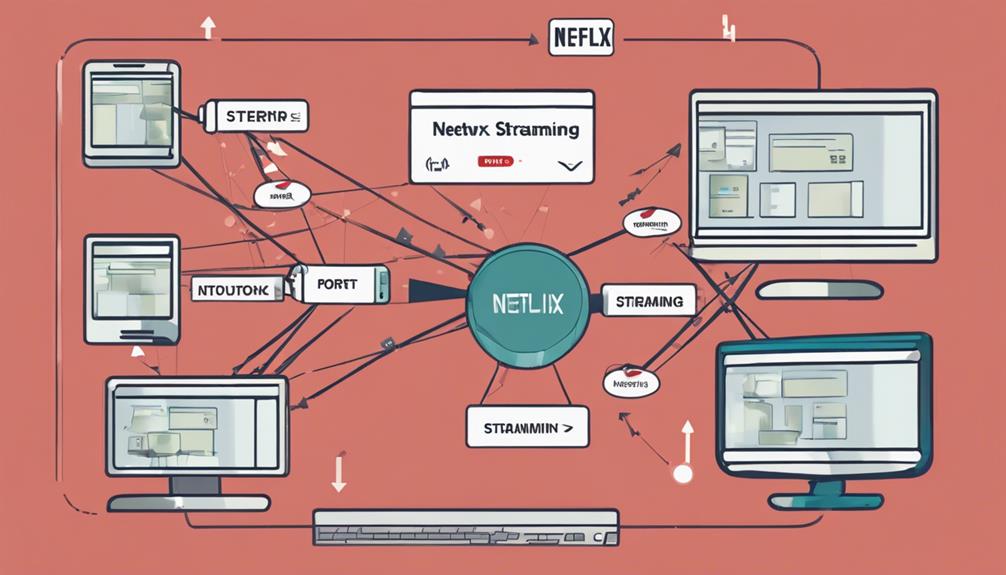So, you think you know everything about Netflix streaming, but do you really understand what port Netflix uses to deliver your favorite shows and movies to your screen?
The answer might surprise you, and knowing this crucial piece of information could significantly impact your viewing experience. Stay tuned to uncover the mystery behind the port that facilitates your seamless Netflix streaming journey.
Key Takeaways
- Netflix streams on port 80 for HTTP and port 443 for HTTPS.
- Port forwarding TCP ports 80 and 443 enhances streaming quality.
- Troubleshoot by ensuring TCP 80, 443, UDP 53, and 123 are open.
- Optimizing network settings prioritizes Netflix streaming performance.
Netflix Streaming Port

When streaming Netflix, devices typically communicate on port 80. This is the default port used by Netflix for streaming content to your devices. Netflix utilizes the HTTP and HTTPS protocols for streaming its content, which are common protocols used for web browsing as well. During playback sessions on devices, Netflix employs similar protocols to those used by web browsers, ensuring a seamless streaming experience.
The HTTP Content-Type for Netflix streaming is x-application/x-gzip, which indicates the type of data being transmitted between Netflix servers and your device. It's essential for ensuring that the data is compressed efficiently for streaming purposes.
However, it's crucial to note that transparent proxies can impact Netflix streaming if not configured correctly. These proxies can interfere with the communication between your device and Netflix servers, leading to buffering issues or playback errors. Therefore, it's essential to ensure that your network configuration is optimized for smooth Netflix streaming.
Understanding Netflix Port
To comprehend the technical aspect of how Netflix operates, understanding the specific ports it utilizes for streaming is essential for troubleshooting potential issues effectively. Netflix primarily streams on port 80 for standard HTTP traffic. This port is widely used for unencrypted web traffic. For secure streaming, Netflix switches to port 443, which is designated for HTTPS traffic.
Port 443 ensures that the data exchanged between your device and Netflix servers is encrypted, enhancing security during streaming sessions. Knowing which ports Netflix uses can assist in diagnosing connectivity problems. If you encounter streaming issues, ensure that your firewall and router settings allow traffic on ports 80 and 443 to establish a seamless connection with Netflix's servers.
Netflix Port Forwarding Guide

For optimal Netflix streaming performance, understanding the principles of port forwarding is crucial. Port forwarding involves configuring a network router to allow incoming internet traffic on specific ports to reach a device on the local network, such as a smart TV or a streaming device.
To ensure a smooth Netflix streaming experience, it's recommended to open TCP ports 80 and 443 for device streaming and secure streaming, respectively. Additionally, specific Netflix services utilize UDP ports 53 and 123. By setting up port forwarding for these ports, you can help ensure that the incoming connection requests destined for Netflix are efficiently directed to your streaming device, reducing potential delays or buffering issues.
Configuring port forwarding correctly can enhance the quality of your Netflix streaming by establishing a direct and efficient connection between your device and Netflix servers. Remember to consult your router's manual or online guides for instructions on how to set up port forwarding and open ports for optimal Netflix streaming performance.
Configuring Netflix Port Settings
To optimize your Netflix streaming performance, understanding how to configure the necessary port settings is essential. Netflix primarily uses TCP ports 80 and 443 for streaming content. Configuring these ports correctly on your network can help ensure a seamless streaming experience. Forwarding ports allows incoming traffic on specific ports to reach your device, enabling efficient communication between Netflix servers and your device.
Here is a table summarizing the key information about configuring Netflix port settings:
| Port Type | Port Number | Protocol |
|---|---|---|
| TCP | 80 | HTTP |
| TCP | 443 | HTTPS |
| UDP | N/A | N/A |
Troubleshooting Netflix Port Issues

If troubleshooting Netflix port issues, ensure that TCP ports 80 and 443, along with UDP ports 53 and 123, are appropriately open for streaming.
To effectively troubleshoot port problems, consider the following:
- Check router settings: Verify that port forwarding rules for Netflix are correctly configured with the IP address of the streaming device.
- Test connectivity: After setting up port forwarding, test the connection to confirm that Netflix streaming is uninterrupted and smooth.
- Consider PureVPN: For secure port forwarding, consider using PureVPN to mitigate network security risks while accessing Netflix content.
Optimizing Network for Netflix
Optimize your network for seamless Netflix streaming by ensuring that ports 80 and 443 are open and accessible for uninterrupted viewing experience. Netflix primarily uses these ports for streaming content over the internet. By prioritizing and optimizing traffic on these specific ports, you can enhance the quality of service for your Netflix streaming sessions.
To effectively optimize your network for Netflix, check that ports 80 and 443 aren't blocked by firewalls or routers. Blocking these ports can lead to connectivity issues and degraded streaming quality. Troubleshooting any problems related to these ports can significantly improve your overall Netflix streaming experience.
Regularly monitoring the status of ports 80 and 443 can help you identify and address any issues promptly. Understanding the significance of these ports in the context of Netflix streaming will empower you to troubleshoot and fine-tune your network settings for optimal performance. Prioritizing the accessibility of these ports is key to ensuring a smooth and enjoyable Netflix viewing experience.
Securing Netflix Streaming Port

Securing the Netflix streaming port reliably involves forwarding TCP port 80 and TCP/UDP port 443 for secure content access. To ensure a smooth and secure streaming experience, consider the following:
- Utilize PureVPN's Port Forwarding Add-on: PureVPN offers a straightforward method to open necessary ports for Netflix streaming. With just a few clicks, you can enhance security and access Netflix content securely.
- Simplify the Process: PureVPN streamlines the port forwarding process, making it easy for users to secure their connection and enjoy uninterrupted Netflix streaming.
- Bypass CGNAT Limitations: The Port Forwarding add-on from PureVPN helps in securely opening ports even behind CGNAT restrictions. By using PureVPN, you can bypass these limitations and ensure a continuous and secure streaming experience on Netflix.
Router Port Setup for Netflix
To configure your router for optimal Netflix streaming, ensure that ports 80 and 443 for TCP, along with ports 53 and 123 for UDP, are correctly set up for port forwarding. Port forwarding allows incoming traffic on these specific ports to reach your streaming device directly, improving the streaming experience. Assigning a static IP address to your device is essential for maintaining consistent port forwarding settings. After configuring the ports and IP address, it is crucial to test the connectivity to verify that the setup is successful and that Netflix streaming is optimized.
| Port Number | Protocol | Purpose |
|---|---|---|
| 80 | TCP | Netflix Streaming |
| 443 | TCP | Netflix Streaming |
| 53 | UDP | Netflix Communication |
| 123 | UDP | Netflix Time Sync |
Setting Up Ports for Netflix

To ensure an optimal Netflix streaming experience, configuring your router to forward ports 80 and 443 for TCP, along with ports 53 and 123 for UDP, is crucial. By setting up port forwarding correctly, you can enhance the performance of streaming services like Netflix.
Here are three key steps to consider:
- Assign Static IP: Allocate a static IP address to your streaming device to ensure that the forwarded ports are consistently directed to the correct device.
- Configure TCP Ports 80 and 443: TCP ports 80 and 443 are fundamental for Netflix streaming as they facilitate the HTTP and HTTPS protocols necessary for content delivery.
- Optimize UDP Ports 53 and 123: Configuring UDP ports 53 and 123 can improve the streaming experience, particularly for live content where real-time data transmission is critical.
Enhancing Netflix Streaming Experience
Enhance your Netflix streaming experience by optimizing network configurations for efficient data transmission and seamless content delivery. When it comes to streaming Netflix, understanding how TCP operates on ports 80 and 443 is crucial. TCP's error recovery and congestion control mechanisms ensure a smooth viewing experience by identifying and resolving issues that may arise during streaming sessions. Additionally, port forwarding can be used to direct traffic specifically for Netflix, improving the speed and reliability of the connection.
To further enhance your streaming quality, consider filtering for the Content-Type x-application/x-gzip used by Netflix. This can help prioritize and streamline the delivery of content, reducing buffering times and enhancing overall performance. By fine-tuning these network settings and leveraging TCP's capabilities, you can optimize your Netflix streaming experience and enjoy your favorite shows and movies without interruption.
Frequently Asked Questions
What Protocol Does Netflix Use to Stream?
When streaming, Netflix uses HTTP and HTTPS protocols to ensure secure data transmission. By employing bandwidth optimization and video compression techniques, Netflix efficiently delivers content to various devices, maintaining a reliable streaming experience for users.
What IP Address Does Netflix Use?
When setting up your network configuration, ensure you allocate IP addresses correctly. Netflix uses various IPs like 52.0.131.132 for specific services. Updating allow lists with Netflix's IP ranges is crucial for seamless access and troubleshooting.
What Port Number Is Streaming?
To optimize your network for streaming, focus on bandwidth usage. Prioritize ports 80 and 443 for Netflix. Configuring routers to allow traffic on these key ports enhances your streaming experience. Smooth playback and data transfer are ensured.
What Domains Does Netflix Use?
You explore Netflix servers and network architecture. Various domains like backlot-api.prod.netflix.net, contenthub.netflixstudios.com, and pegasusasperaprod.us-east-1.dynprod.netflix.net are part of their infrastructure. Meechum service resides on meechum.netflix.com over TCP port 443.





